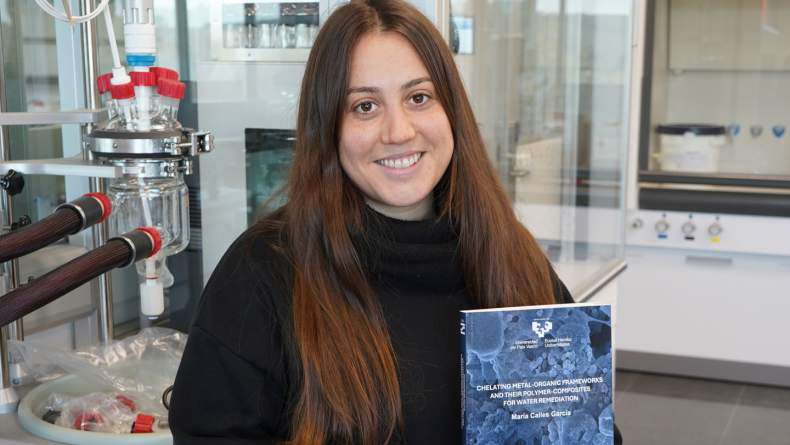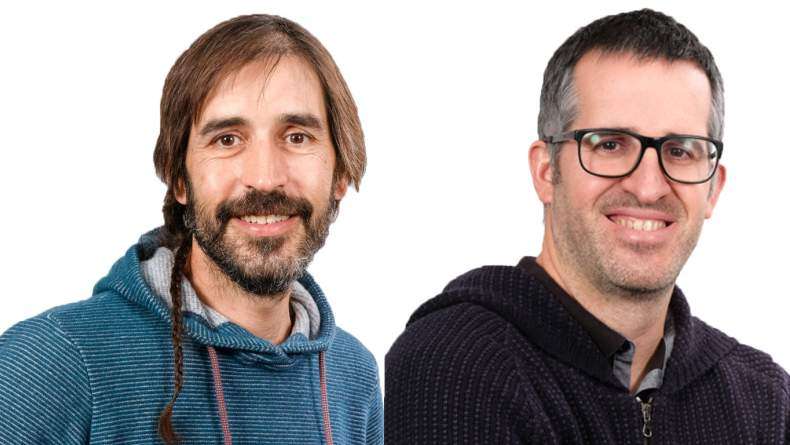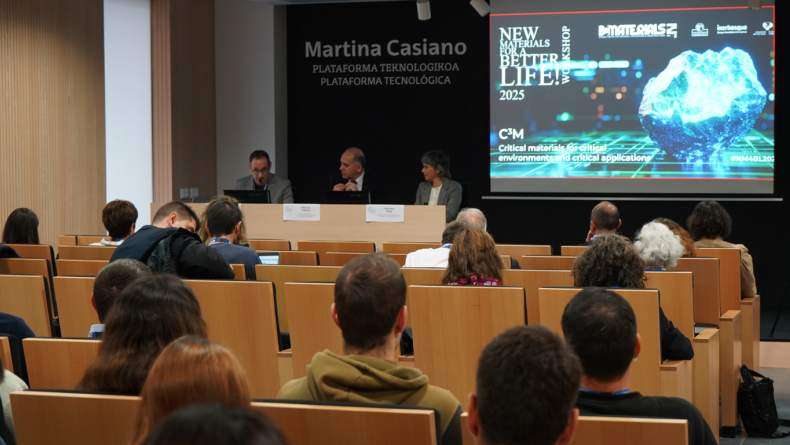BCMaterials Invited Talk: Sergey Kustov " “Microeddy Bordoni-type relaxation controls spin glass transitions?”

Next Thursday 18th BCMaterials and ZTF-FCT (UPV-EHU) present a Sergey Kustov Talk: “ Microeddy Bordoni-type relaxation controls spin glass transitions!?"
Seminario del Departamento de Electricidad y Electrónica 12:00 p.m.
 Acoustic techniques have not so far been used to study magnetic domain wall freezing effect typical for re-entrant spin glass transitions. Application of this method, which includes simultaneous measurements of linear microeddy and non-linear hysteretic magnetomechanical damping, to various materials having relatively low Curie temperatures (pure element – Dy, several types of ferromagnetic bulk metallic glasses, BMG), reveals the following regularities:
- a strong decrease of the long-range mobility of domain walls (or domain wall “freezing” effect) is controlled by a discovered linear microeddy current anelastic relaxation phenomenon;
- the microeddy relaxation is accompanied by a number of effects typical for the re-entrant spin glass transition as anomalies in magnetization, coercive force, magnetostriction, broken ergodicity;
- the microeddy current relaxation, which controls seemingly all (low field) magnetic properties is observed in completely different (in terms of crystallography and magnetism) materials, like pure Dy and BMGs;
- once the Curie temperature falls below the relaxation temperature, the re-entrant spin glass transition transforms into the spin glass one;
Based on the similarity of microeddy relaxation features in different ferromagnetic systems we propose that the relaxation is related to intrinsic properties of domain walls. We draw an analogy between the observed magnetic relaxation and the Bordoni anelastic relaxation due to the kink pair formation on a dislocation line.
One can assume that similar intrinsic properties of topological defects (domain walls) might control “glassy” transitions in other physical systems, like ferroelectrics and martensites
Acoustic techniques have not so far been used to study magnetic domain wall freezing effect typical for re-entrant spin glass transitions. Application of this method, which includes simultaneous measurements of linear microeddy and non-linear hysteretic magnetomechanical damping, to various materials having relatively low Curie temperatures (pure element – Dy, several types of ferromagnetic bulk metallic glasses, BMG), reveals the following regularities:
- a strong decrease of the long-range mobility of domain walls (or domain wall “freezing” effect) is controlled by a discovered linear microeddy current anelastic relaxation phenomenon;
- the microeddy relaxation is accompanied by a number of effects typical for the re-entrant spin glass transition as anomalies in magnetization, coercive force, magnetostriction, broken ergodicity;
- the microeddy current relaxation, which controls seemingly all (low field) magnetic properties is observed in completely different (in terms of crystallography and magnetism) materials, like pure Dy and BMGs;
- once the Curie temperature falls below the relaxation temperature, the re-entrant spin glass transition transforms into the spin glass one;
Based on the similarity of microeddy relaxation features in different ferromagnetic systems we propose that the relaxation is related to intrinsic properties of domain walls. We draw an analogy between the observed magnetic relaxation and the Bordoni anelastic relaxation due to the kink pair formation on a dislocation line.
One can assume that similar intrinsic properties of topological defects (domain walls) might control “glassy” transitions in other physical systems, like ferroelectrics and martensites
 Acoustic techniques have not so far been used to study magnetic domain wall freezing effect typical for re-entrant spin glass transitions. Application of this method, which includes simultaneous measurements of linear microeddy and non-linear hysteretic magnetomechanical damping, to various materials having relatively low Curie temperatures (pure element – Dy, several types of ferromagnetic bulk metallic glasses, BMG), reveals the following regularities:
- a strong decrease of the long-range mobility of domain walls (or domain wall “freezing” effect) is controlled by a discovered linear microeddy current anelastic relaxation phenomenon;
- the microeddy relaxation is accompanied by a number of effects typical for the re-entrant spin glass transition as anomalies in magnetization, coercive force, magnetostriction, broken ergodicity;
- the microeddy current relaxation, which controls seemingly all (low field) magnetic properties is observed in completely different (in terms of crystallography and magnetism) materials, like pure Dy and BMGs;
- once the Curie temperature falls below the relaxation temperature, the re-entrant spin glass transition transforms into the spin glass one;
Based on the similarity of microeddy relaxation features in different ferromagnetic systems we propose that the relaxation is related to intrinsic properties of domain walls. We draw an analogy between the observed magnetic relaxation and the Bordoni anelastic relaxation due to the kink pair formation on a dislocation line.
One can assume that similar intrinsic properties of topological defects (domain walls) might control “glassy” transitions in other physical systems, like ferroelectrics and martensites
Acoustic techniques have not so far been used to study magnetic domain wall freezing effect typical for re-entrant spin glass transitions. Application of this method, which includes simultaneous measurements of linear microeddy and non-linear hysteretic magnetomechanical damping, to various materials having relatively low Curie temperatures (pure element – Dy, several types of ferromagnetic bulk metallic glasses, BMG), reveals the following regularities:
- a strong decrease of the long-range mobility of domain walls (or domain wall “freezing” effect) is controlled by a discovered linear microeddy current anelastic relaxation phenomenon;
- the microeddy relaxation is accompanied by a number of effects typical for the re-entrant spin glass transition as anomalies in magnetization, coercive force, magnetostriction, broken ergodicity;
- the microeddy current relaxation, which controls seemingly all (low field) magnetic properties is observed in completely different (in terms of crystallography and magnetism) materials, like pure Dy and BMGs;
- once the Curie temperature falls below the relaxation temperature, the re-entrant spin glass transition transforms into the spin glass one;
Based on the similarity of microeddy relaxation features in different ferromagnetic systems we propose that the relaxation is related to intrinsic properties of domain walls. We draw an analogy between the observed magnetic relaxation and the Bordoni anelastic relaxation due to the kink pair formation on a dislocation line.
One can assume that similar intrinsic properties of topological defects (domain walls) might control “glassy” transitions in other physical systems, like ferroelectrics and martensitesRelated news
María Calles, BCMaterialseko doktore berria
María Calles García zoriondu nahi dugu UPV/EHUn Materialen Zientzia eta Teknologian doktoretza lortzeagatik. Abenduaren 4an Maríak ‘Chelating Metal-Organic Frameworks and Their Polymer-Composites…Bartzelonako Mikroelektronika Institutuko ikertzaileekin hitzaldi gonbidatua (abenduak 3)
Datorren abenduaren 3an, 12:00etatik aurrera Leioako Martina Casiano auditorioan, BCMaterialsek Bartzelonako Mikroelektronika Institutuko (IMB-CNM) (CSIC) Antón Guimerà eta Xavier Illa ikertzaile…Hitzaldi gonbidatua Liu Yaorekin metal-litiozko bateriei buruz (abenduak 2)
Datorren astelehenean, abenduaren 2an, Liu Yao Shanghai Institute of Applied Physics-eko irakasleak "Li Metal Batteries: From Liquid to Solid-State" hitzaldia aurkeztuko du BCMaterials-en. Hitzaldia…BCMaterials-en urteko workshoparen arrakasta, material kritikoei eskainia
BCMaterialsen urteko workshoparen 2025. edizio arrakastatsuak ehun bat lagun bildu zituen azaroaren 19an Leioan, artearen egoera aztertzeko eta material kritikoei, materialen aplikazio kritikoei eta…



